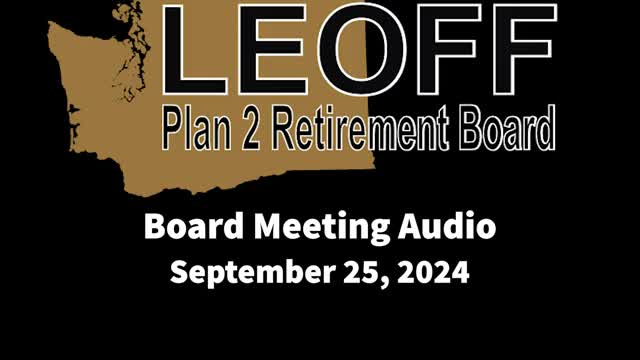Board Faces Pressure Over Retiree COLA Amid Rising Inflation
September 25, 2024 | Law Enforcement Officers' and Fire Fighters' Plan 2 Retirement Board, Governor's Office - Boards & Commissions, Executive, Washington
This article was created by AI summarizing key points discussed. AI makes mistakes, so for full details and context, please refer to the video of the full meeting. Please report any errors so we can fix them. Report an error »

During a recent government board meeting, officials addressed the pressing issue of inflation significantly surpassing projections, raising concerns among retirees regarding the adequacy of their cost-of-living adjustments (COLAs). The discussion highlighted the impact of inflation on retirees' purchasing power and the mechanisms in place to adjust their benefits accordingly.
Steve, a board member, initiated the conversation by outlining the long-term inflation assumptions, which were set at 2.75%. However, recent inflation rates have far exceeded this figure, particularly noting an alarming 8.81% inflation rate in 2022. This discrepancy has led to worries about how long it will take for current COLAs to restore lost earning power for retirees.
The board explored various types of COLAs utilized in pension plans across the country, emphasizing the importance of balancing benefit adequacy, plan sustainability, and affordability. Washington State's pension plans feature different COLA structures, including automatic and ad hoc adjustments, compounding options, and inflation-based calculations. Notably, the Lehi 1 plan offers a compounding automatic COLA without a cap, while the Lehi 2 plan has a capped COLA at 3%.
A significant point of discussion was the COLA banking system, which allows for the accumulation of unused COLA adjustments during years of lower inflation. The board requested an actuarial analysis to determine the cost of immediately paying out the accumulated COLA banks to retirees, which was estimated at $650 million. This payout would alter the funded status of the pension plan from 102% to 98%. The actuaries noted that while the total payout would be approximately $930 million, anticipated savings of $280 million were factored in due to adjustments in long-term inflation assumptions.
The meeting underscored the urgency of addressing retirees' financial security in light of rising inflation and the complexities of pension plan adjustments. As discussions continue, the board is tasked with considering options to support retirees in regaining their purchasing power amidst ongoing economic challenges.
Steve, a board member, initiated the conversation by outlining the long-term inflation assumptions, which were set at 2.75%. However, recent inflation rates have far exceeded this figure, particularly noting an alarming 8.81% inflation rate in 2022. This discrepancy has led to worries about how long it will take for current COLAs to restore lost earning power for retirees.
The board explored various types of COLAs utilized in pension plans across the country, emphasizing the importance of balancing benefit adequacy, plan sustainability, and affordability. Washington State's pension plans feature different COLA structures, including automatic and ad hoc adjustments, compounding options, and inflation-based calculations. Notably, the Lehi 1 plan offers a compounding automatic COLA without a cap, while the Lehi 2 plan has a capped COLA at 3%.
A significant point of discussion was the COLA banking system, which allows for the accumulation of unused COLA adjustments during years of lower inflation. The board requested an actuarial analysis to determine the cost of immediately paying out the accumulated COLA banks to retirees, which was estimated at $650 million. This payout would alter the funded status of the pension plan from 102% to 98%. The actuaries noted that while the total payout would be approximately $930 million, anticipated savings of $280 million were factored in due to adjustments in long-term inflation assumptions.
The meeting underscored the urgency of addressing retirees' financial security in light of rising inflation and the complexities of pension plan adjustments. As discussions continue, the board is tasked with considering options to support retirees in regaining their purchasing power amidst ongoing economic challenges.
View full meeting
This article is based on a recent meeting—watch the full video and explore the complete transcript for deeper insights into the discussion.
View full meeting
